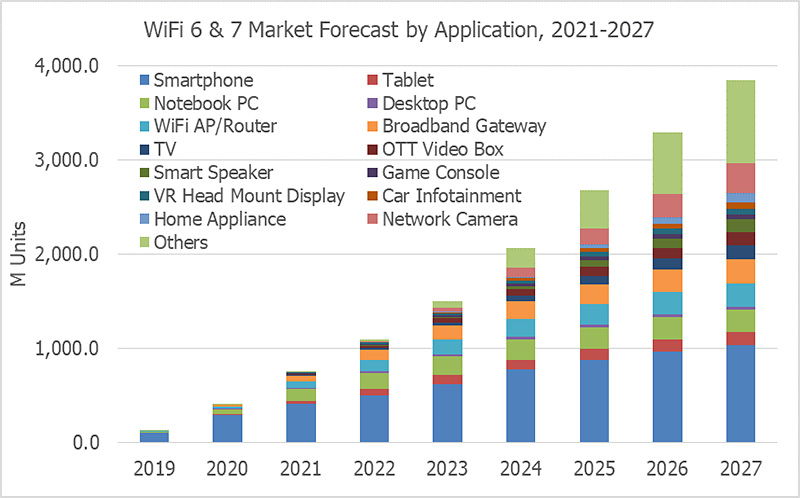[ad_1]
By Takeshi Niwa, Marketing Analyst at TSR (Techno Systems Research Co., Ltd).
WiFi has been expanding its capacity and applications from computer and networking, to mobile, consumer and IoT related devices. WiFi industry set WiFi 6 standard to cover both low power IoT nodes and broadband applications. WiFi 6E and WiFi 7 adds new 6GHz spectrum to address higher bandwidth applications such as 8k video and XR display. New 6GHz spectrum is also expected for high reliable industrial IoT use cases by improving interference and latency.
This article will discuss WiFi market and applications, especially focus on new WiFi 6E and WiFi 7 standards.
WiFi Market and Application

After the strong market growth in 2021, WiFi market is forecasted to grow by 4.1%, about 4.5 billion units in 2022. We forecast mid-single digit growth through 2023-2027, reaching about 5.7 billion units in 2027. Smart home, automotive and embedded IoT applications supports WiFi device shipment growth.
WiFi 6 market started in 2019 and grew rapidly during 2020 and 2022. WiFi 6 occupies about 24% of total WiFi market in 2022. By 2027, WiFi 6 and WiFi 7 together will account about 2/3 of WiFi market. 6GHz WiFi 6E and WiFi 7 will grow from 4.1% in 2022 to 18.8% in 2027.
6GHz WiFi 6E market start picking up in 2021 initially in the USA market, followed by Europe market in 2022. WiFi 7 device will start to ship in 2023, and expected to surpass WiFi 6E shipments in 2025.
6GHz WiFi takes great advantages in broadband, gaming, video streaming applications, also in specific industrial IoT use cases which requires high reliable, low latency communication like factory robotics automation and AGV. 6GHz WiFi also improves the accuracy of WiFi positioning.
However, there are two major challenges for 6GHz WiFi market deployment, spectrum availability and additional cost. 6GHz spectrum allocation policy is different by country. Under the current policy, China and Russia will not allocate 6GHz spectrum for WiFi. China government currently plans to use 6GHz for 5G. Absence of China, the largest WiFi market, will negatively impact WiFi 7 market growth in the future.
Another challenge for 6GHz WiFi is the additional cost for RF front end (wideband PA, switch, and filter). New WiFi 7 chipset will add another cost in digital baseband/MAC part to enhance data throughput. Thus, 6GHz WiFi will be mainly adopted in developed countries and high end smart devices.
WiFi suppliers start shipping 2.4GHz single band WiFi 6 chipset in 2021 to replace legacy WiFi 4 which is widely adopted in IoT devices. New features like TWT (Target Wake Time) and BSS color benefits IoT devices by adding lower power operation and better spectrum usage. 2.4GHz Single Band WiFi 6 will take 13% market share by 2027.

For applications, WiFi access point/router/broadband gateway, premium smartphone, and PC are the first to adopt WiFi 6 in 2019, remains main applications so far. In 2022, smartphone, PC and WiFi networking device accounts 84% of WiFi 6/6E shipments. During 2021-2022, broader range of WiFi application moves to WiFi 6. Smart home devices like smart TV and smart speaker start to adopt WiFi 6 in 2021. In 2022, home and industrial IoT applications, automotive start to adopt WiFi 6 standard.
WiFi networking, high end smartphone and PCs are the main applications of WiFi 6E/WiFi 7. In addition, 8k TV and VR headset are also expected as 6GHz WiFi main application. In 2025, 6GHz WiFi 6E will be adopted in automotive infotainment and industrial automation use cases.
Single Band WiFi 6 is expected to be adopted in low data speed WiFi applications, such as home appliance, home IoT devices, IP Camera, smart wearables and industrial automation..
WiFi 6/7 Chipset
Qualcomm, Broadcom and Intel were the first to introduce WiFi 6 chipset to the market in 2019, followed by Infineon (Cypress), NXP, MediaTek, On Semiconductor, MaxLinear (Intel), and Renesas (Celeno) in 2020. During 2021-2022, Synaptics, Realtek, Espressif and Beken join the competition.
In 2021, Broadcom (for smartphone, tablet, PC, WiFi networking), Qualcomm (for smartphone, tablet, PC, WiFi networking), and Intel (for PC) together accounts over 85% market share in WiFi 6 chip market. However, MediaTek, NXP, On Semiconductor and others gains market share in 2021. WiFi 6 chip market share will be more diversified as WiFi 6 adoption expand in broader applications.
WiFi 7 chipset has been announced in 2Q2022, at the same time when WiFi 7 draft 2 (WiFi 7 Release 1) standard was released. Qualcomm, Broadcom and MediaTek takes lead in WiFi 7 chipset release. Intel is also expected to release WiFi 7 chipset by early 2023.
Among WiFi 7 chipsets, MediaTek and Broadcom (for mobile devices) employs 6/7nm advanced semiconductor process node. Since 6/7nm IC design requires huge development cost, this is the barrier for small/mid-size semiconductor companies to develop high end WiFi 7 chipset in the future.
For single Band WiFi 6 chipset, Espressif leads in production, followed by Beken and AIC Semiconductor. Chinese IC suppliers is leading the way to adopt WiFi 6 in IoT WiFi chipset.
[ad_2]
Image and article originally from iotbusinessnews.com. Read the original article here.


